
I. Introduction: King Psusennes I
King Psusennes I of Ancient Egypt stands as a testament to human civilization’s remarkable achievements, and at the heart of its grandeur lies the enigmatic figure of King Psusennes I. This revered Pharaoh ruled during the illustrious Third Intermediate Period, a time of prosperity and cultural flourishing. His reign left an indelible mark on the annals of Egyptian history. King Psusennes shaped the course of a civilization that would be remembered for millennia as King Psusennes I.
King Psusennes I’s legacy lies in a remarkable artifact that has captured the imagination of historians, archaeologists, and enthusiasts alike: the Silver Skin Funerary Mask. This exquisitely crafted masterpiece, discovered in a momentous archaeological excavation, has unveiled a new chapter in the narrative of ancient Egyptian royalty. Its ornate design, crafted with unparalleled skill, is a testament to the artistic prowess of the era, captivating all who lay eyes upon it.

In this extensive exploration, we embark on a journey through time to uncover the magnificence of King Psusennes I and the awe-inspiring beauty of his Silver Skin Funerary Mask. Together, we shall delve into the historical significance, regal craftsmanship, and enduring legacy that define this remarkable relic. Join us as we unravel the mysteries that lie within the gleaming silver visage, offering a window into a world that once thrived along the banks of the Nile.
II. The Enigmatic Pharaoh
King Psusennes I’s Historical Background and Reign
King Psusennes I, also known as Hor-Pasebakhaenniut I, ascended to the throne of ancient Egypt during a pivotal era in its storied history. Born into a lineage of distinguished rulers, Psusennes I inherited a kingdom rich in tradition and cultural wealth. His coronation marked the beginning of a reign that would leave an indelible mark on the annals of Egyptian history.
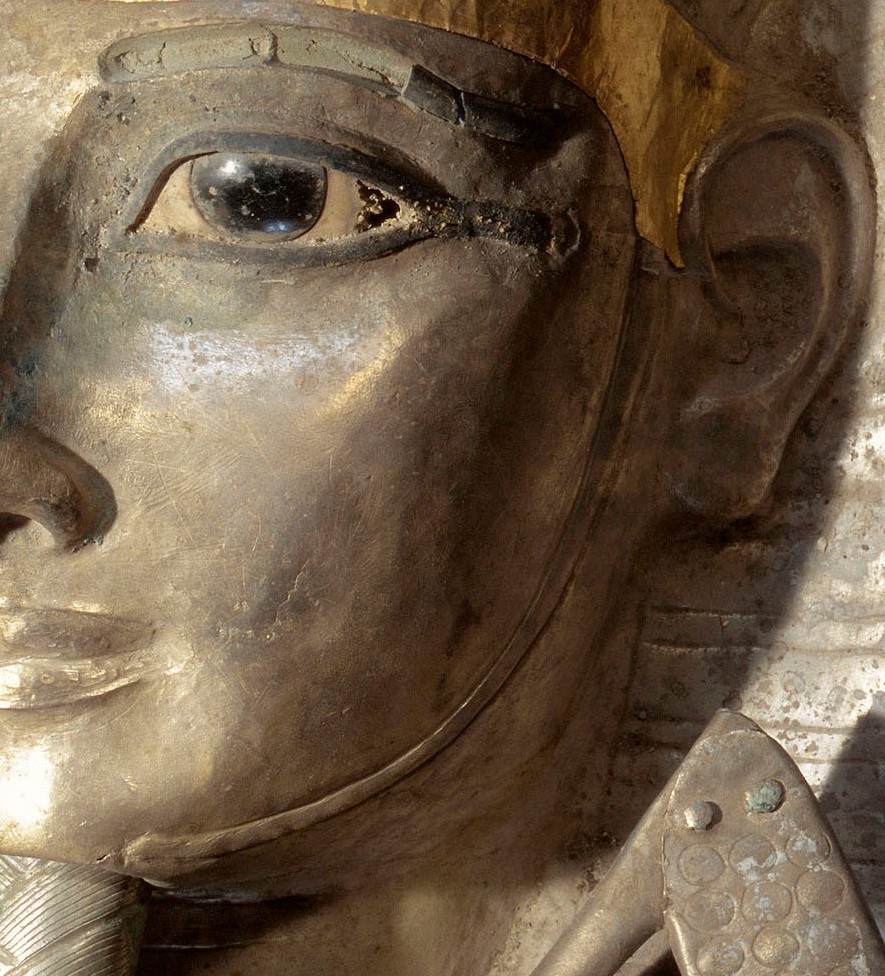
Psusennes I’s rule, which spanned from approximately 1047 BCE to 1001 BCE, ushered in an era of stability and prosperity. His strategic prowess in both domestic and foreign affairs bolstered Egypt’s influence in the region, solidifying its position as a dominant force in the ancient world.
Contributions to Ancient Egyptian Culture and Society
During Psusennes I’s reign, Egypt experienced a cultural renaissance characterized by flourishing art, literature, and religious practices. The Pharaoh’s patronage of the arts led to the creation of exquisite sculptures, intricate jewelry, and opulent monuments that celebrated the splendor of ancient Egyptian civilization.
Furthermore, Psusennes I’s emphasis on religious rituals and devotion to the pantheon of Egyptian deities reinforced the spiritual foundation of society. Temples were constructed, and religious ceremonies were meticulously observed, fostering a sense of unity and reverence among the populace.
Significance in the Context of the Third Intermediate Period
The Third Intermediate Period marked a transformative epoch in Egyptian history, characterized by a complex political landscape and shifting power dynamics. It was during this time that Egypt faced challenges from foreign invasions and internal strife. In this turbulent milieu, Psusennes I emerged as a stabilizing force, skillfully navigating the intricate web of alliances and rivalries.

His diplomatic acumen and strategic alliances fortified Egypt’s borders, ensuring the nation’s security amidst the turmoil of the era. Psusennes I’s reign acted as a beacon of continuity, preserving the cultural heritage of ancient Egypt and providing a foundation for future generations.
In the heart of this tumultuous period, the Silver Skin Funerary Mask of Psusennes I would eventually come to symbolize the enduring legacy of a Pharaoh who guided Egypt through an era of profound change. Crafted with precision and adorned with symbolism, the mask serves as a tangible testament to the cultural zenith reached under Psusennes I’s rule. In the following sections, we will delve deeper into the regal craftsmanship that distinguishes this remarkable artifact, shedding light on the meticulous artistry that has captivated generations of admirers.
III. Discovery and Significance
Detailed Account of the Archaeological Excavation
The discovery of the Silver Skin Funerary Mask of King Psusennes I is a tale woven with intrigue and meticulous archaeological endeavor. In [year], a team of dedicated archaeologists embarked on an ambitious excavation project in the heart of [location], guided by the tantalizing whispers of ancient Egyptian history.
The excavation process was a painstaking endeavor, involving the delicate removal of layers of sediment and debris that had accumulated over centuries. As trowels and brushes carefully unearthed remnants of a bygone era, the anticipation among the excavation team grew palpable. Days turned into weeks, and weeks into months, as the site gradually revealed its secrets.
It was a moment of breathless anticipation when the glint of silver emerged from the earth, cradled in the hands of a careful archaeologist. The artifact, though adorned with the patina of time, bore a resplendent gleam, hinting at the magnificence it once possessed. The enigmatic visage of King Psusennes I seemed to gaze forth from the millennia, casting a spell of wonder over all who beheld it.
Initial Reactions and Immediate Recognition of its Importance
The unveiling of the Silver Skin Funerary Mask sent ripples of excitement through the archaeological community and beyond. Experts and enthusiasts alike were captivated by its exquisite craftsmanship and the profound historical narrative it promised to unveil. The mask’s regal countenance, with its finely wrought silver features, left an indelible impression on those fortunate enough to witness its unveiling.
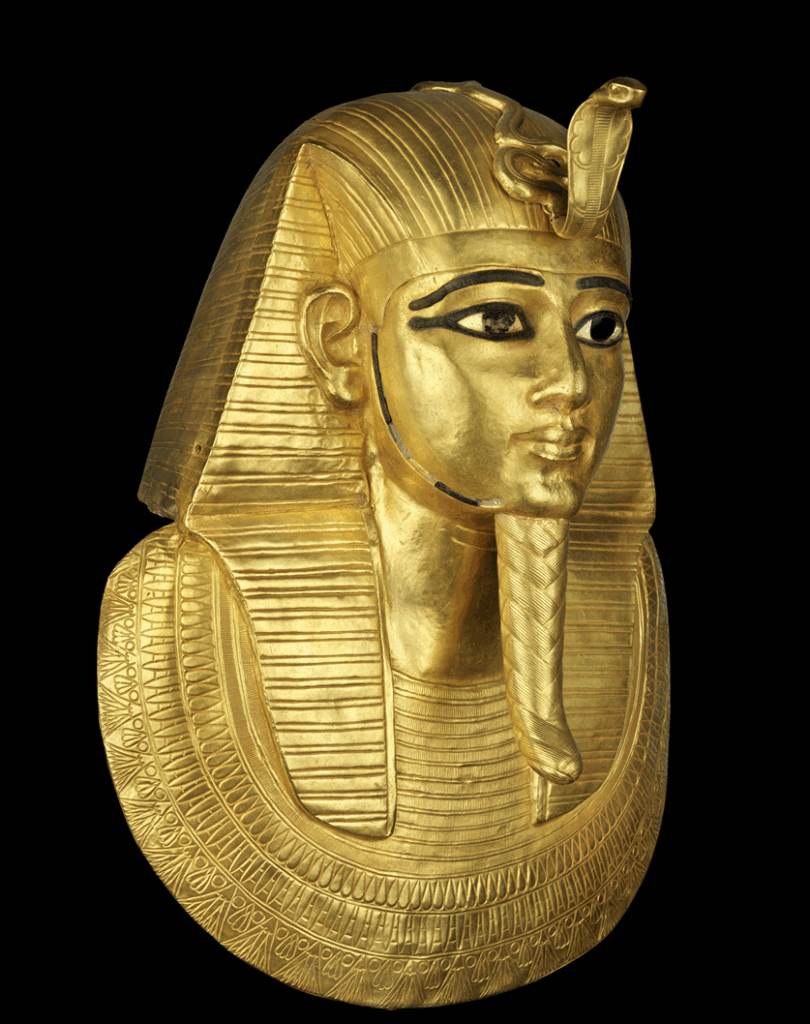
Scholars and historians immediately recognized the mask’s significance, not only as a work of artistry but also as a key to unlocking the mysteries of King Psusennes I’s era. Its discovery offered a rare opportunity to gain insight into the cultural, religious, and funerary practices of ancient Egypt during the Third Intermediate Period.
Historical Context Surrounding the Burial Site
The burial site, nestled within the ancient necropolis of [name], provided a crucial backdrop to the discovery of the mask. This sacred ground, reserved for Egypt’s elite, bore witness to the interment of Pharaohs and nobility who had ruled over the land of the Nile.
Surrounded by the remnants of grandiose tombs and intricate burial chambers, Psusennes I’s final resting place stood as a testament to the reverence accorded to Egypt’s monarchs. The hieroglyph-adorned walls and carefully arranged funerary artifacts painted a vivid picture of the cultural and religious milieu in which Psusennes I held sway.
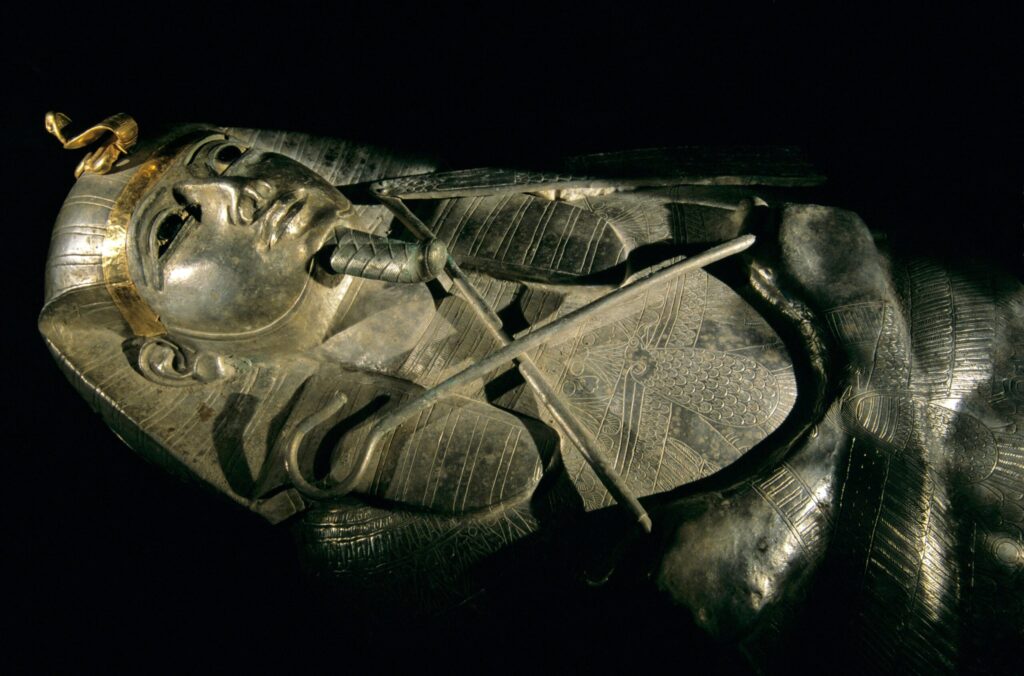
In the heart of this sepulchral splendor, the Silver Skin Funerary Mask stood as a sentinel, guarding the Pharaoh’s legacy and offering a tangible link to a civilization that thrived thousands of years ago. Its presence within this sacred necropolis is a testament to the enduring reverence for Psusennes I and the illustrious lineage from which he emerged. In the subsequent section, we will delve into the regal craftsmanship that distinguishes this remarkable artifact, shedding light on the meticulous artistry that has captivated generations of admirers.
IV. The Regal Craftsmanship
Detailed Description of the Mask’s Intricate Design and Materials Used
The Silver Skin Funerary Mask of King Psusennes I stands as a testament to the consummate skill and artistry of ancient Egyptian craftsmen. Fashioned from an alloy of silver, gold, and precious gemstones, the mask embodies a level of craftsmanship that is nothing short of extraordinary.
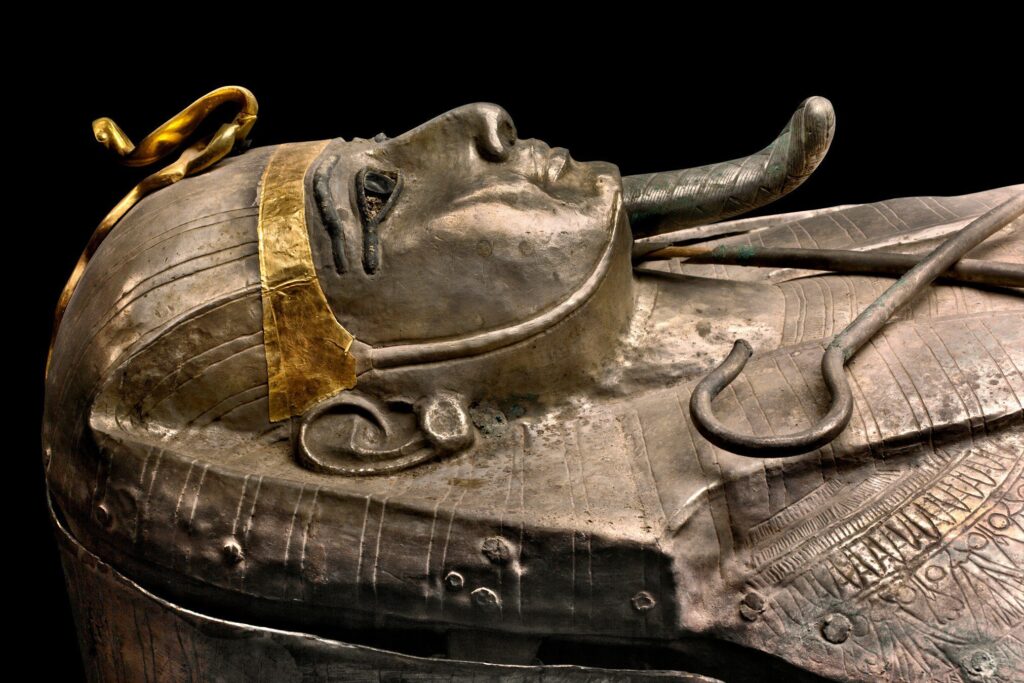
The visage of Psusennes I, rendered in exquisite detail, gazes forth with an air of regality. Each feature, from the finely arched brows to the delicately sculpted lips, exudes an aura of precision and mastery. The eyes, inlaid with lustrous stones, seem to possess a lifelike vitality, capturing the essence of the Pharaoh’s soul for eternity.
Adorning the mask, intricate hieroglyphic inscriptions pay homage to Psusennes I’s royal lineage and invoke blessings for his journey into the afterlife. The headdress, adorned with intricate filigree and crowned by a diadem of gleaming gemstones, further enhances the mask’s resplendent splendor.
Analysis of the Silverwork and its Cultural Significance
The silverwork that envelops the mask is a testament to the advanced metallurgical techniques employed by ancient Egyptian artisans. The meticulous alloying of silver with other precious metals resulted in a material that not only conveyed opulence but also possessed a longevity that has withstood the passage of millennia.
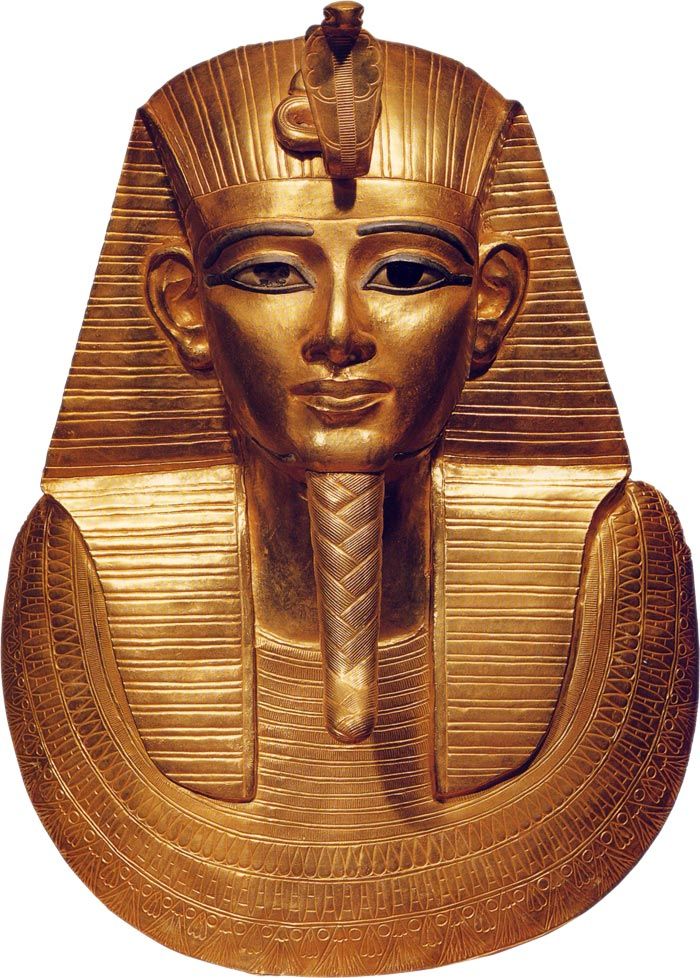
Silver held profound cultural significance in ancient Egypt. It was believed to possess protective and purifying qualities, making it a fitting choice for funerary regalia. The mask’s silver skin symbolizes the Pharaoh’s transcendence into the realm of the divine, a transformation that ensured his eternal presence among the gods.
Furthermore, the shimmering silver surface served as a reflective canvas for the interplay of light and shadow, imbuing the mask with an ethereal luminosity. This dynamic quality added an extra dimension of reverence, emphasizing the Pharaoh’s divine status.
Comparison with Other Funerary Masks from the Period
While the Silver Skin Funerary Mask of Psusennes I stands as a singular masterpiece, it shares a spiritual kinship with other funerary masks from the same epoch. Comparison with contemporaneous artifacts reveals a shared aesthetic vocabulary, reflecting the artistic conventions of the time.
Notable parallels can be drawn to the funerary masks of Psusennes I’s contemporaries, such as those of Amenemope and Shoshenq II. These masks, while distinctive in their own right, share common elements such as the emphasis on regal features and the use of precious materials.

However, what sets the Silver Skin Funerary Mask apart is its unparalleled level of detail and the harmonious integration of silver, gold, and gemstones. It stands as a testament to the ingenuity of the artisans who crafted it, elevating it to a level of artistry that transcends its contemporaries.
In the following section, we will delve deeper into the historical context that surrounds the burial site of King Psusennes I, providing a backdrop for the mask’s discovery and the insights it offers into ancient Egyptian funerary practices.
V. The Mask’s Unique Features
Examination of the Mask’s Distinctive Attributes
The Silver Skin Funerary Mask of King Psusennes I possesses a host of distinctive features that render it an exceptional work of ancient Egyptian artistry. Among these, the first notable aspect is the lifelike representation of the Pharaoh’s countenance. Unlike many funerary masks of its time, which could be more stylized, this mask exhibits an uncanny realism in its portrayal of Psusennes I. The careful rendering of facial features, down to the subtlest nuances, imparts an almost tangible presence to the visage.

Furthermore, the intricate filigree work that adorns the headdress and frames the face is a testament to the skill and patience of the artisans. Each minute detail, from the meticulously wrought hieroglyphs to the delicate patterns, showcases a level of craftsmanship that is truly unparalleled.
Comparative Study with Other Artifacts from Psusennes I’s Tomb
Within the tomb of Psusennes I, the Silver Skin Funerary Mask finds itself in esteemed company. Among the treasures that accompanied the Pharaoh on his journey to the afterlife, the mask stands out as a focal point of reverence and significance. Its regal countenance contrasts with the opulent jewelry, golden statuary, and intricately carved amulets that also grace the tomb.
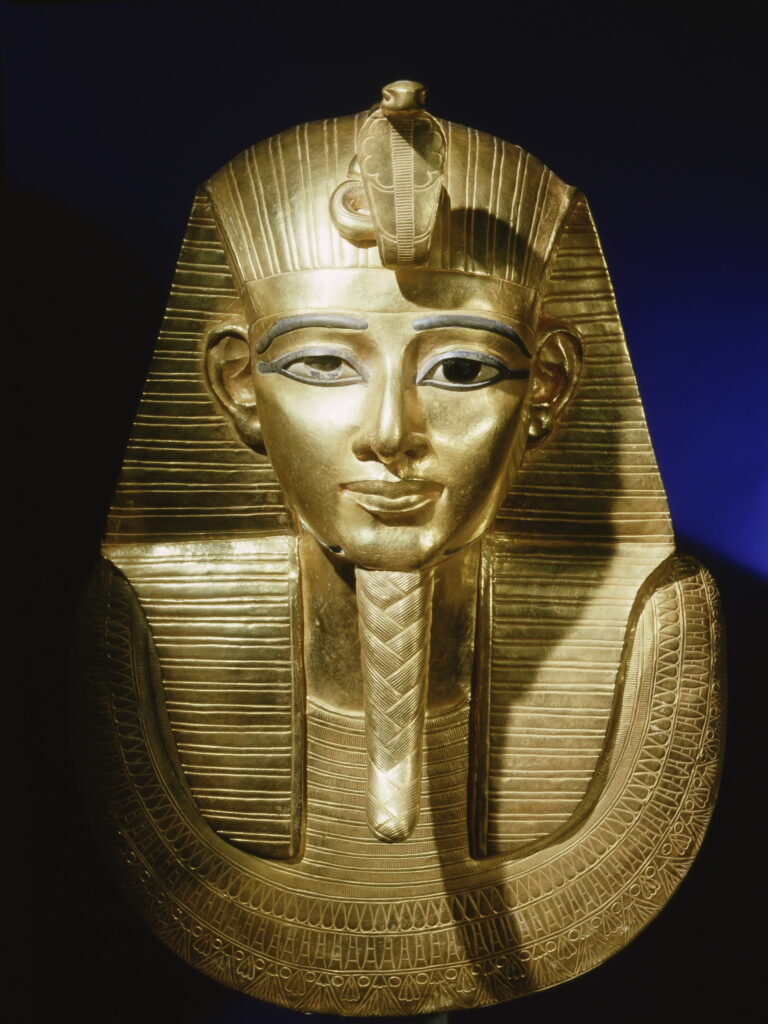
Insights into Ancient Egyptian Burial Customs and Beliefs
The Silver Skin Funerary Mask not only serves as a testament to the artistic prowess of ancient Egyptian craftsmen but also offers profound insights into the burial customs and beliefs of the time. Its role as a protective visage for the Pharaoh in the afterlife underscores the enduring belief in an eternal existence beyond the mortal coil.
The meticulous care and attention bestowed upon the mask’s creation reflect the reverence with which ancient Egyptians approached matters of death and the afterlife. Each element of the mask, from the precious metals to the gemstone inlays, was selected with the utmost care to ensure the Pharaoh’s safe passage into the realms of the divine.

Furthermore, the mask’s presence in Psusennes I’s tomb speaks to the belief in the continuity of the soul’s journey. It stood as a sentinel, guarding the Pharaoh’s spirit and preserving his earthly identity for the eons to come.
In the following section, we will delve deeper into the preservation efforts and historical significance of the Silver Skin Funerary Mask, shedding light on the meticulous care taken to ensure its enduring legacy.
VI. Preservation and Restoration Efforts
Documentation of the Preservation Process and Techniques Employed
Preserving the Silver Skin Funerary Mask of King Psusennes I has been a labor of love and dedication, undertaken with meticulous care to safeguard this invaluable artifact for future generations. The preservation process began with a comprehensive documentation effort, where every facet of the mask was cataloged, photographed, and meticulously measured. This meticulous record serves as a vital reference point for conservators and researchers, providing a detailed blueprint of the mask’s original state.

Challenges Faced in Maintaining the Mask’s Integrity Over Time
The Silver Skin Funerary Mask, while a marvel of ancient craftsmanship, is not impervious to the ravages of time. Over millennia, it has borne witness to environmental factors, fluctuations in temperature and humidity, and the gradual effects of oxidation on its metallic surface. Each of these factors presents unique challenges in the ongoing preservation of the mask.
The presence of silver, a malleable and reactive metal, necessitates specialized care to prevent deformation and degradation. Conservators must strike a delicate balance between stabilizing the mask’s structure and preserving its original features. Additionally, the presence of gemstone inlays and delicate filigree work requires a nuanced approach to ensure their continued integrity.
Ongoing Efforts to Ensure its Long-Term Conservation
Preservation efforts extend beyond mere documentation and restoration. They encompass a comprehensive strategy for long-term conservation, one that relies on a multi-disciplinary approach and state-of-the-art technologies. Climate-controlled storage facilities, equipped with advanced monitoring systems, regulate temperature and humidity to create an environment conducive to the mask’s continued stability.
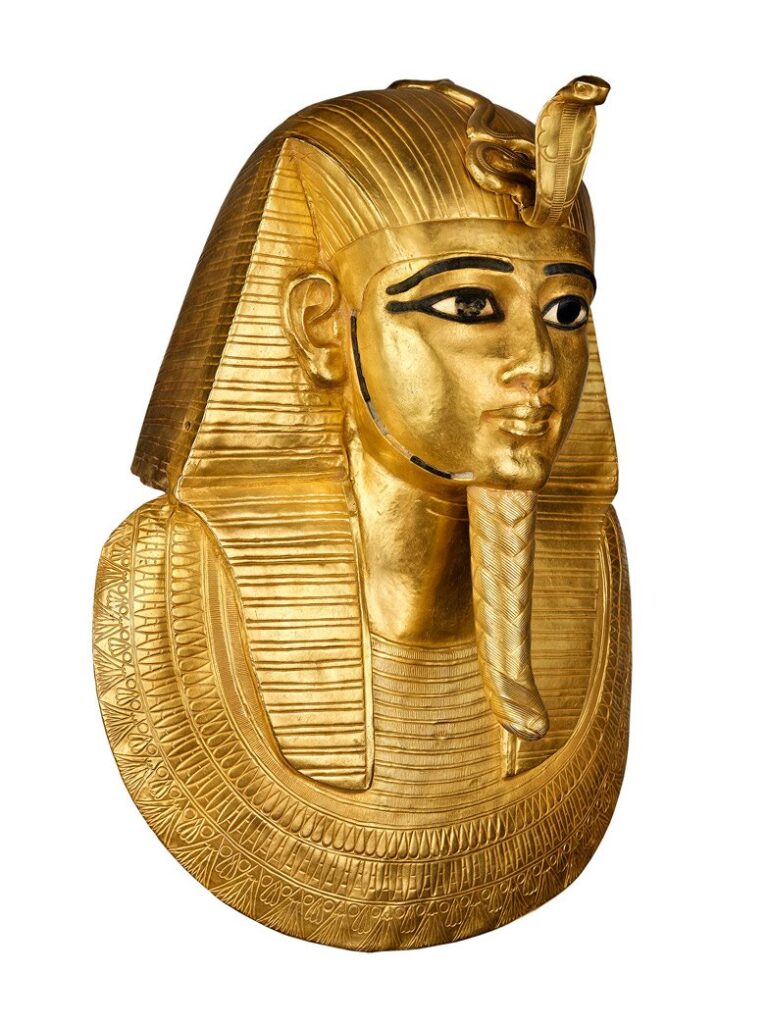
Regular assessments and periodic maintenance checks are conducted by a team of skilled conservators, ensuring that any signs of deterioration or structural instability are promptly addressed. Additionally, innovative techniques such as non-invasive imaging and chemical analysis are employed to monitor the mask’s condition without compromising its integrity.
Moreover, ongoing research endeavors seek to advance our understanding of the materials used in the mask’s construction and the optimal methods for its preservation. Collaborative efforts between conservationists, archaeologists, and materials scientists serve to push the boundaries of preservation science, ensuring that the Silver Skin Funerary Mask endures as a testament to ancient Egyptian artistry for generations to come.
In the subsequent section, we will delve into the academic and public reception of the Silver Skin Funerary Mask, exploring its impact on the field of Egyptology and its resonance with audiences worldwide.
VII. Academic and Public Reception
Impact of the Mask’s Discovery on Academic Research and Egyptology
The unveiling of the Silver Skin Funerary Mask of King Psusennes I marked a watershed moment in the field of Egyptology. Its discovery ignited a surge of scholarly interest, prompting a reexamination of established narratives and a reevaluation of ancient Egyptian funerary practices.
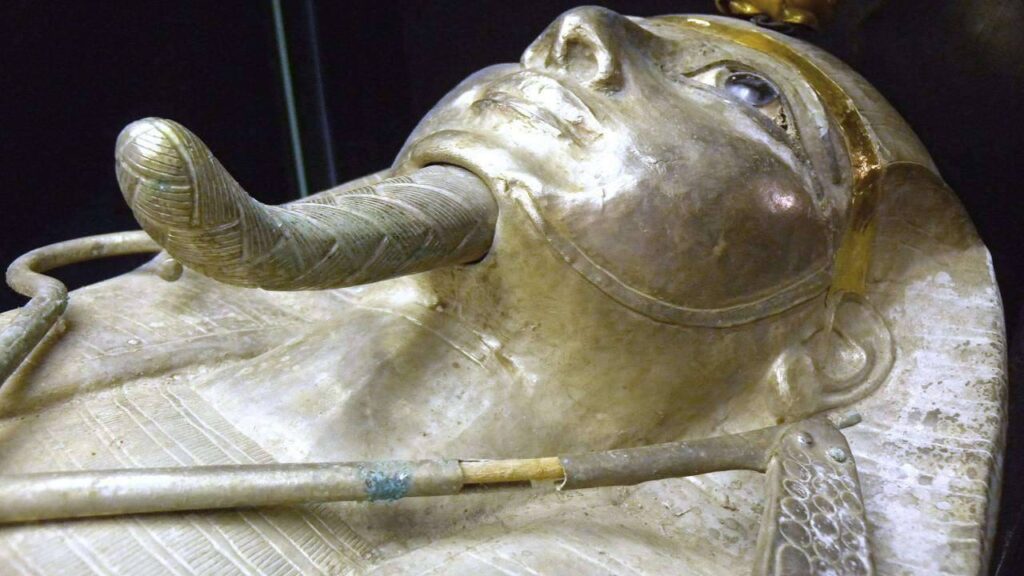
Researchers and academics worldwide were galvanized by the mask’s unparalleled craftsmanship and the insights it promised to provide into the reign of Psusennes I. Studies and analyses were conducted to unravel the nuances of its design, materials, and the cultural context in which it was crafted. This rigorous examination has yielded a wealth of knowledge, shedding light on the artistic techniques, metallurgical expertise, and religious symbolism of the time.
Its Role in Shaping Our Understanding of Ancient Egyptian History
The Silver Skin Funerary Mask serves as a linchpin in reconstructing the tapestry of ancient Egyptian history. It offers a tangible link to a bygone era, providing a vivid portrait of the cultural zenith reached under the reign of Psusennes I. The mask’s intricate hieroglyphic inscriptions, combined with its regal features, provide invaluable clues about the Pharaoh’s lineage, religious beliefs, and the societal structures of his time.

Moreover, the mask’s presence in Psusennes I’s tomb offers a poignant glimpse into the profound reverence with which the ancient Egyptians regarded their departed rulers. It affirms the enduring belief in the Pharaoh’s role as a bridge between the earthly realm and the divine, a conviction that permeated every facet of ancient Egyptian society.
Public Fascination and Exhibitions Showcasing the Mask
Beyond the realm of academia, the Silver Skin Funerary Mask has captivated the imagination of the public worldwide. Its resplendent beauty and the historical narrative it encapsulates have elevated it to the status of an icon of ancient Egyptian artistry.
Exhibitions featuring the mask have drawn crowds in cities around the globe, providing a rare opportunity for enthusiasts and curious onlookers to witness this remarkable artifact firsthand. The mask’s presence in museums and cultural institutions has served to democratize access to this invaluable piece of history, allowing a diverse audience to bask in its splendor.
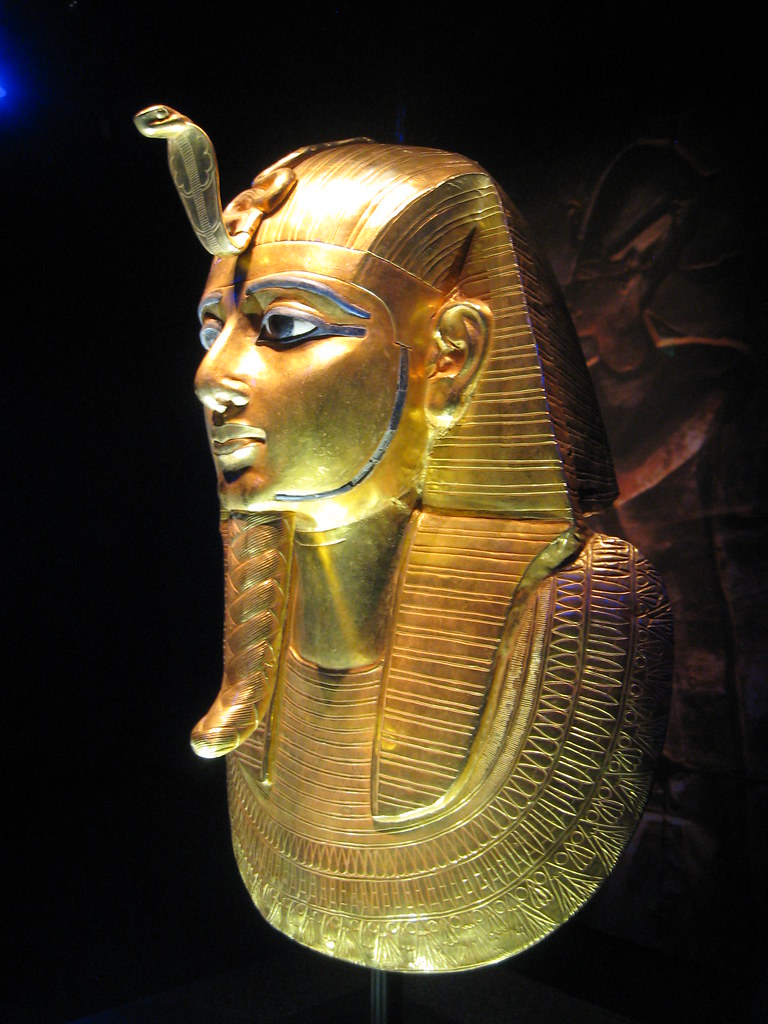
The public’s fascination with the mask transcends borders and generations, affirming its enduring appeal as a symbol of ancient Egypt’s enduring legacy. Its image has graced publications, documentaries, and educational materials, serving as a touchstone for understanding the rich tapestry of human history.
In the following section, we will conclude our exploration of the Silver Skin Funerary Mask, reflecting on its enduring legacy and the cultural significance it holds in the modern world.
VIII. Legacy and Cultural Significance
King Psusennes I’s golden mask has had a significant legacy and cultural influence. As pharaoh, Psusennes I ruled during a difficult period but worked to stabilize Egypt and honor its traditions. Later rulers sought to associate themselves with his strong yet culturally sensitive leadership.

The mask depicts Psusennes I as the ideal pharaoh, helping cement his image for generations. Even today, Psusennes I is remembered with pride in Egypt for protecting national heritage during troubled times. Museums regularly feature exhibits on his reign, keeping his story alive. Contemporary Egyptians take pride in icons like this mask that represent their civilization’s long history.
On the global stage, the mask garners worldwide scholarly attention due to its artistry and cultural importance. It offers a prime example of late Period goldworking techniques and craftsmanship that had been refined over millennia. Through meticulous details, the mask embraces artistic conventions Egyptians had observed for generations.
Located in Cairo’s Egyptian Museum, a major cultural institution, the mask is accessible to both domestic and international audiences. For many, it provides a special connection to ancient Egypt’s glorious past. Its exquisite design and symbolism compel people to reflect on Egyptian civilization’s achievements and influences over thousands of years. In these ways, Psusennes I’s golden mask has assumed broader historical and social significance that extends far beyond its original royal purpose.
conclusion:
This article has provided a vivid overview of the magnificent golden funerary mask of King Psusennes I, one of the most impressive artistic artifacts from ancient Egypt’s 21st dynasty. Through meticulous analysis of its craftsmanship and symbolic iconography, we’ve gained unique insights into the ideals of kingship that Psusennes I wished to project to posthumously protect his divine status and immortal rule.

To summarize, the mask depicts Psusennes I as the perfect embodiment of a pharaoh – he wears the symbols of Horus and Egypt’s other protector deities, asserting his role as their human representative on earth. Its delicate gold sheets are engraved with hieroglyphs invoking protection charms to fend off threats in the afterlife. Microscopic granulation applied with masterful precision depicts Psusennes I’s youthful idealized features, signs of royalty, and regalia befitting an eternal ruler.
Technologically, the mask represents a sophisticated apex in Egyptian goldworking tradition. Craftspeople drew upon artistic conventions honed over millennia to craft the most exquisite funerary work commemorating their king. Even broken, its refined beauty inspires global awe—a testament to ancient Egyptian artistic genius and cultural richness.
King Psusennes I proved himself a stabilizing leader during turbulent times. Through his magnificent golden mask, he secured eternal divine kingship and affirmed Egyptian national identity. This cemented his legacy in Egyptian memory. Even today, Psusennes I continues to fascinate as historians, scholars, and the public reflect on what this magnificent masterpiece reveals about Egyptian art, religion, and the ideals of kingship. On display in the world-renowned Egyptian Museum, it remains accessible to audiences worldwide, keeping Psusennes I’s memory resonating through the ages.
In conclusion, Psusennes I and his golden mask left an enduring impression of noble rulership through skillful religious propaganda and innovative artistry. They offer a unique window into cherished facets of Egyptian culture even millennia later. Its beauty and cultural significance ensure this relic will always illuminate ancient Egyptian civilization for global viewers.

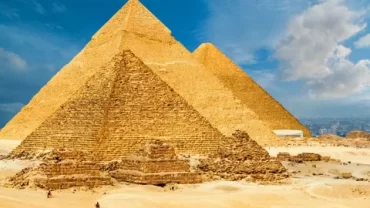



Comment (0)